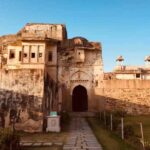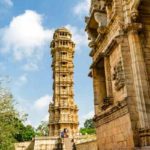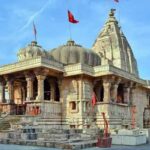18 Places to visit in Chittorgarh, a symbol of Rajputana valor and pride, is a must-visit for history buffs and cultural enthusiasts. At the heart of Chittorgarh’s allure is the Chittorgarh Fort, sprawling atop a hill and offering panoramic views of the city. This UNESCO World Heritage Site is not just a fort but a symbol of courage, with tales of heroism, sacrifice, and the famous jauhar (self-immolation) of Rani Padmini.
Another significant landmark is the Vijay Stambha (Victory Tower), erected by Maharana Kumbha to commemorate his victory over the Muslim rulers of Malwa and Gujarat. The intricate carvings and inscriptions on this nine-story tower are a sight to behold, offering a glimpse into the past.
For those seeking spiritual solace, the Meera Temple, dedicated to the devout follower of Lord Krishna, is a serene spot. Its Rajput architecture and the story of Meera Bai’s devotion add a mystical charm.
Lastly, don’t miss the Gaumukh Reservoir, an architectural marvel and a source of water for the fort. Its peaceful surroundings make it a perfect spot for reflection. Each of these places not only showcases Chittorgarh’s grandeur but also tells the stories of its glorious past Chittorgarh Tourism.
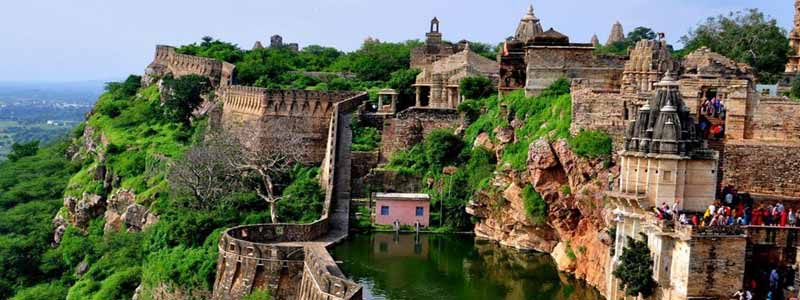
Chittorgarh fort
The Chittorgarh Fort, a symbol of the valiant spirit of the Rajput warriors, stands majestically atop a hill in the heart of Rajasthan, India. Spread over 700 acres, it is not only a testament to Rajput heroism but also a UNESCO World Heritage Site that showcases the opulence of Indian feudal architecture. The fort’s history is replete with tales of bravery, sacrifice, and honor, echoing the battles and sieges it endured, especially against the Mughal invasions chittorgarh Tour Packages.
Dominating the fort’s skyline are the Vijay Stambha (Victory Tower) and the Kirti Stambha (Tower of Fame), both of which are exemplary of the architectural and cultural grandeur of the past. The fort houses several palaces, temples, and towers that speak volumes of the medieval Rajputana style. The Rana Kumbha Palace within its bounds is a hauntingly beautiful ruin that whispers stories of the past, including the tale of Rani Padmini’s jauhar (self-immolation) to avoid dishonor at the hands of invaders.
The Chittorgarh Fort is not just an architectural marvel but also a pilgrimage for those who honor courage and freedom. Its vastness and beauty continue to attract tourists from around the globe, making it a must-visit for anyone exploring the rich tapestry of India’s heritage.
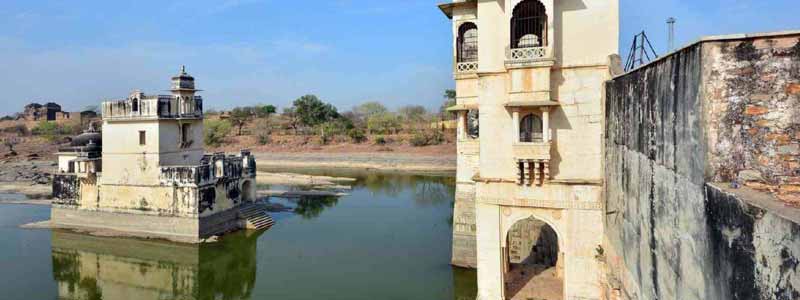
Padmini Palace
Padmini Palace, nestled within the formidable Chittorgarh Fort, is a historical edifice that embodies the tales of valor, honor, and the tragic beauty of Queen Padmini, around whom many legends of Chittorgarh revolve. This palace is a poignant reminder of the rich yet tumultuous history of Rajasthan, symbolizing the valor and dignity of the Rajput kingdoms.
The palace itself, though modest in size compared to the vast expanse of the fort, is an architectural marvel. It is surrounded by water bodies, which were strategically designed for protection and to provide a cooling effect in the arid climate of Rajasthan. The reflection of the palace in the waters of the lotus pond is a sight to behold, presenting a serene yet hauntingly beautiful image that captures the essence of Queen Padmini’s legendary beauty.
According to popular lore, it was the reflection of Queen Padmini from this palace that enamored Sultan Alauddin Khilji, leading to the infamous siege of Chittorgarh. While the historical accuracy of these tales is often debated, the allure of Padmini Palace lies in its ability to transport visitors back in time, offering a glimpse into the lives of those who walked its corridors centuries ago. Visiting Padmini Palace is not just an exploration of a historical site but an immersive experience into the heart of Rajputana pride and the timeless tales that make Chittorgarh a symbol of Rajasthani heritage 18 Places to visit in Chittorgarh.
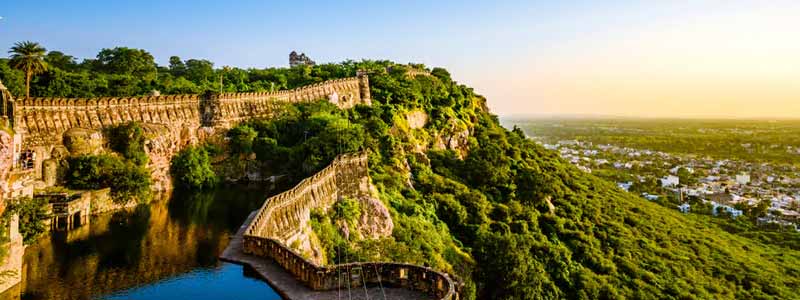
Gomukh Kund
The Gaumukh Kund, also known as the Gaumukh Reservoir, is a fascinating and spiritually significant site within the historic boundaries of Chittorgarh Fort, Rajasthan, India. Its name, ‘Gaumukh,’ translates to ‘cow’s mouth,’ which is reflective of the shape of the spring that feeds the tank, resembling the mouth of a cow. This ancient water reservoir is an architectural marvel, ingeniously designed to collect and store rainwater, showcasing the advanced water management system of the past 18 Places to visit in Chittorgarh.
Legend has it that this kund (tank) is a place of deep spiritual significance, with waters considered sacred, offering solace and purity to those who visit. The water continuously flows from a natural spring, believed to originate from the Sanjeevani Mountain, carried here to aid in the miraculous healing of Lakshman in the epic tale of Ramayana. Pilgrims and tourists alike are drawn to Gaumukh Kund, not just for its historical value, but for the peace and sanctity it offers amidst the ruins of the majestic fort.
Surrounded by the imposing fort walls and ancient ruins, the Gaumukh Kund serves as a serene escape, offering a glimpse into the ingenious architectural practices and spiritual ethos of ancient India. Its timeless waters, enriched with stories and legends, continue to fascinate and beckon visitors from around the world.
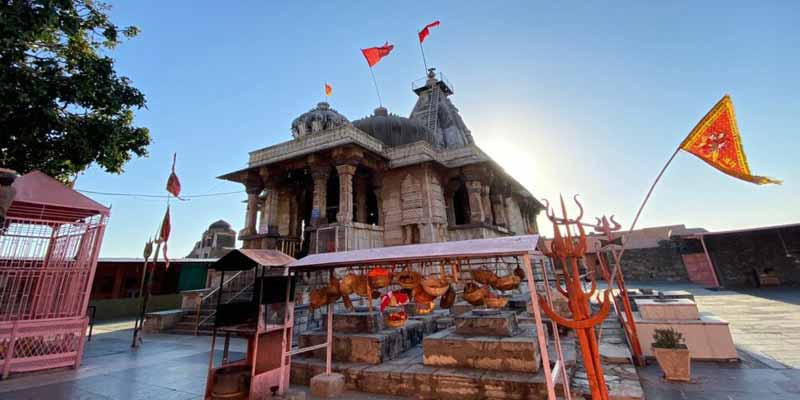
Kalika Mata Temple
The Kalika Mata Temple, positioned within the southern part of the majestic Chittorgarh Fort in Rajasthan, India, is a significant symbol of spiritual heritage and devotion. Originally built in the 8th century as a sun temple, it was later dedicated to the goddess Kali, the embodiment of power and victory, in the 14th century. This historical transformation reflects the dynamic spiritual landscape of India, where temples often evolve to honor different deities, embodying the fluid nature of Hindu worship practices.
The temple stands as a testament to the medieval architecture that characterizes the fort complex. Visitors are greeted by its simple yet profound structure, which resonates with the aura of devotion and ancient traditions. The ambiance inside the temple is charged with spirituality, offering a peaceful retreat for pilgrims and tourists alike. The deity, Goddess Kali, is revered here in her fierce form, symbolizing the destruction of evil and protection of the righteous.
Pilgrims from across the country visit the Kalika Mata Temple, especially during the Navaratri festival, when the temple premises come alive with fervent devotion, rituals, and celebrations. The temple not only serves as a place of worship but also as a beacon of the rich cultural and religious tapestry that defines Chittorgarh, making it a must-visit for those exploring the fort’s expansive heritage.
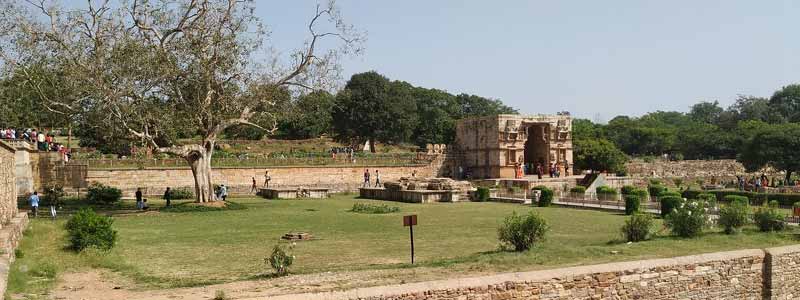
Maha Sati
The Maha Sati area in Chittorgarh stands as a somber reminder of Rajasthan’s ancient practice of sati, where widows immolated themselves on their husbands’ funeral pyres. This historic site is deeply ingrained with the tragic tales of royal women who chose death over dishonor following the defeat of their husbands in battles. The most poignant of these tales is linked to the siege of Chittorgarh by Emperor Akbar in 1568, leading to a mass sati of Rajput women, including the queen, to avoid capture and enslavement, 18 Places to visit in Chittorgarh.
The Maha Sati area is not just a place of mourning; it’s a symbol of the ultimate sacrifice made by the women of Chittorgarh, showcasing their unwavering loyalty, honor, and courage. Visitors to this site are greeted with an atmosphere of profound respect and reflection. The area is adorned with several memorials and cenotaphs, each telling the story of the brave souls who chose death over dishonor.
While the practice of sati was banned in the 19th century and is condemned today, the Maha Sati area remains a significant historical site. It offers visitors a glimpse into the harsh realities of the past, the depth of devotion, and the extreme forms of resistance against subjugation. It’s a place that commands respect and contemplation, making it an essential visit for those looking to understand the complex fabric of Rajasthani and Indian history.
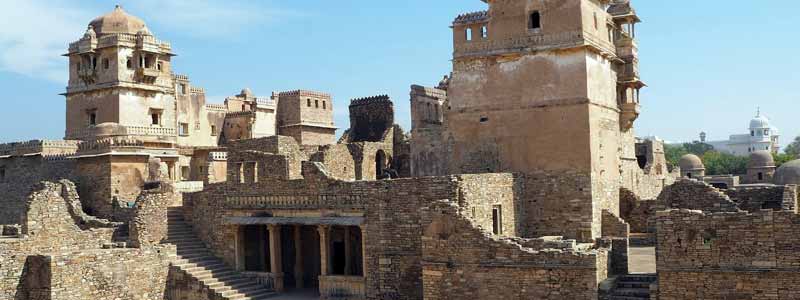
Rana Kumbha palace
Rana Kumbha Palace, located within the formidable Chittorgarh Fort in Rajasthan, India, is a poignant testament to the regal splendor and architectural brilliance of the bygone era. Constructed in the 15th century by Rana Kumbha, a ruler of the Mewar dynasty, this palace served as the royal residence and witnessed the grandeur of Rajputana glory.
Despite enduring centuries of weathering and battles, the palace still exudes an aura of majesty, though much of it lies in ruins today. Its imposing structure, characterized by intricately carved pillars, balconies, and arches, offers glimpses into its erstwhile opulence. The palace’s layout, with its courtyards and chambers, reflects the sophisticated architectural style prevalent during that period, 18 Places to visit in Chittorgarh.
Historically, the Rana Kumbha Palace holds immense significance as it was here that Maharana Udai Singh, the founder of Udaipur, was born. Additionally, it served as a witness to several significant events in Indian history, including the siege of Chittorgarh by Alauddin Khilji.
Visiting Rana Kumbha Palace provides a captivating journey through time, allowing visitors to envision the grandeur of Rajasthan’s royal past while marveling at the resilience of its architectural marvels. It stands as a poignant reminder of the valor and legacy of the Rajput kings who once ruled this land.
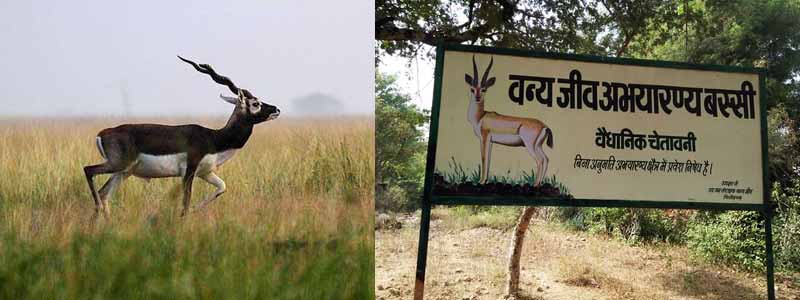
Bassi Wildlife Sanctuary
Bassi Wildlife Sanctuary, nestled in the foothills of the Aravalli Range near Chittorgarh, Rajasthan, offers a tranquil escape into nature’s embrace. Spread over approximately 50 square kilometers, this sanctuary is a haven for biodiversity enthusiasts and wildlife lovers.
The sanctuary is characterized by its diverse ecosystem, comprising dry deciduous forests, rocky terrain, and water bodies. It provides a habitat for various species of flora and fauna, including panthers, wild boars, sloth bears, antelopes, and numerous bird species like partridges, quails, and peafowls.
Visitors can explore the sanctuary through guided safaris and nature walks, immersing themselves in the natural beauty and serenity of the surroundings. The picturesque landscapes and the chance to spot wildlife in their natural habitat make it a captivating experience for visitors of all ages.
Apart from wildlife sightings, the sanctuary also offers opportunities for birdwatching, photography, and picnics amidst the scenic backdrop of the Aravalli hills. With its peaceful ambiance and abundant natural treasures, Bassi Wildlife Sanctuary is a must-visit destination for nature enthusiasts seeking solace and adventure amidst Rajasthan’s rugged terrain 18 Places to visit in Chittorgarh.
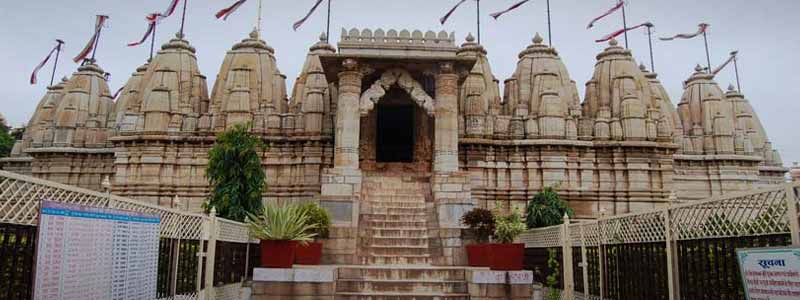
Sathis Deori Temple
Sathis Deori Temple, nestled in the ancient city of Chittorgarh, Rajasthan, is a captivating blend of architectural brilliance and spiritual significance. This temple, dedicated to Lord Shiva, holds immense historical and religious importance, drawing devotees and tourists alike.
Constructed in the 8th century, Sathis Deori Temple is renowned for its intricate carvings, reflecting the artistic mastery of the craftsmen of that era. The temple’s architecture showcases a blend of Nagara and Dravidian styles, with its shikhara (spire) adorned with ornate sculptures and motifs 18 Places to visit in Chittorgarh.
Devotees flock to Sathis Deori Temple to seek the blessings of Lord Shiva and experience a sense of tranquility amidst its sacred ambiance. The temple’s sanctum sanctorum houses a revered lingam, symbolizing the divine presence of Lord Shiva.
Beyond its religious significance, Sathis Deori Temple stands as a testament to the rich cultural heritage of Chittorgarh and serves as a reminder of the city’s glorious past. Visitors can immerse themselves in the spiritual aura of the temple while marveling at its architectural grandeur, making it a must-visit destination for those exploring the historical and cultural gems of Rajasthan.
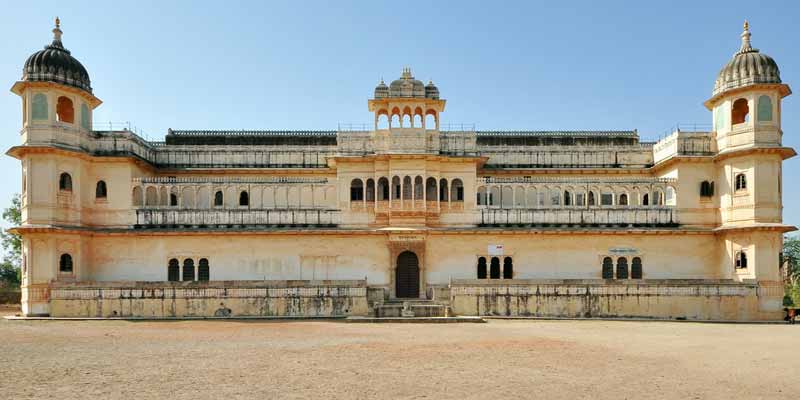
Fateh Prakash Palace
Fateh Prakash Palace, nestled within the majestic Chittorgarh Fort in Rajasthan, India, is a stunning architectural marvel that reflects the grandeur of Rajput heritage. Constructed during the 19th century, this palace served as the residence of Maharana Fateh Singh, the ruler of Mewar.
The palace boasts of intricate Rajputana architecture, characterized by elaborate domes, balconies, and exquisite carvings that adorn its façade. Its interiors are adorned with beautiful frescoes, delicate mirror work, and ornate furnishings, offering a glimpse into the opulent lifestyle of the erstwhile rulers of Mewar.
Visitors to Fateh Prakash Palace can explore its various chambers, courtyards, and halls, each steeped in history and legend. The palace also houses a museum that showcases a rich collection of artifacts, including royal belongings, weapons, paintings, and sculptures, providing insight into the cultural heritage of the region 18 Places to visit in Chittorgarh.
Beyond its historical significance, Fateh Prakash Palace offers panoramic views of the surrounding landscape, with the sprawling Chittorgarh Fort and the serene waters of the Gaumukh Reservoir creating a mesmerizing backdrop.
For travelers seeking to immerse themselves in the regal splendor and rich history of Rajasthan, a visit to Fateh Prakash Palace in Chittorgarh is a truly unforgettable experience.
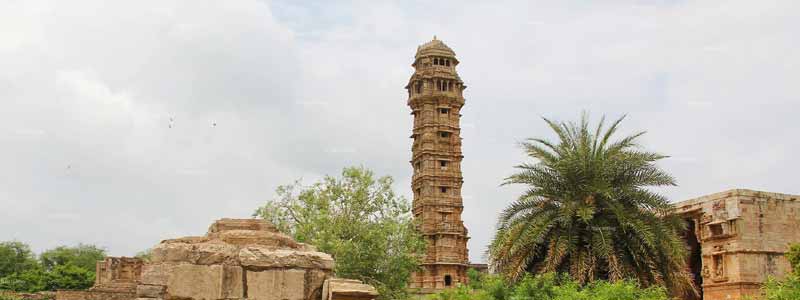
Victory Tower or Vijay Stambh
The Vijay Stambha, or Victory Tower, stands as an iconic symbol of triumph and valor within the grandeur of Chittorgarh Fort in Rajasthan, India. Built in the 15th century by Maharana Kumbha of the Mewar dynasty, this towering structure is a marvel of Rajput architecture and craftsmanship.
Rising to a height of 37 meters over multiple stories, the Vijay Stambha is adorned with intricate carvings, depicting scenes from Hindu mythology, battles, and the Rajput ethos of honor and bravery. Each level of the tower showcases meticulous detailing, with sculptures of gods, goddesses, warriors, and mythical creatures intricately chiseled into the stone.
The construction of the Vijay Stambha was initiated to commemorate a significant victory by Maharana Kumbha against the combined forces of Malwa and Gujarat. Its towering presence not only served as a symbol of victory but also as a testament to the indomitable spirit and martial prowess of the Rajput warriors 18 Places to visit in Chittorgarh.
Visitors to Chittorgarh are captivated by the awe-inspiring sight of the Vijay Stambha, which stands as a testament to the rich history and cultural heritage of Rajasthan, inviting them to delve into the tales of valor and glory that echo through its ancient walls.
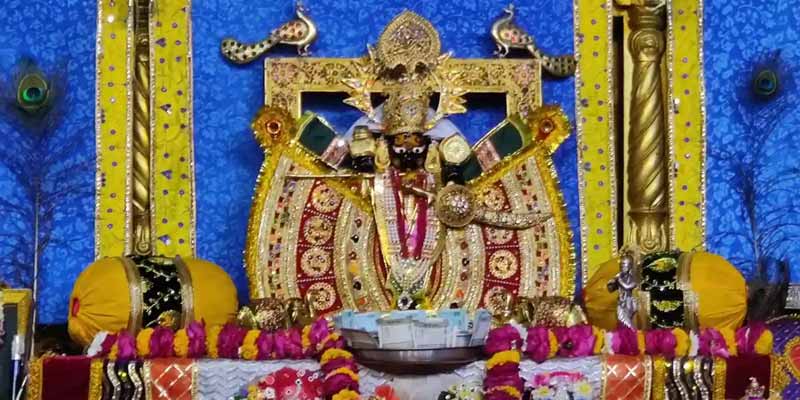
Sanwariaji Temple
The Sanwariaji Temple in Chittorgarh, Rajasthan, is a revered Hindu shrine dedicated to Lord Krishna, particularly in his manifestation as Sanwaria Seth. Situated around 40 kilometers from the main city of Chittorgarh, this temple attracts devotees from far and wide, especially during festivals like Janmashtami and Holi.
The temple is renowned for its stunning architecture, featuring intricate carvings and embellishments that reflect the rich cultural heritage of Rajasthan. Its towering spires and ornate facade draw visitors not only for religious purposes but also for architectural admiration 18 Places to visit in Chittorgarh.
Devotees flock to the temple to seek the blessings of Sanwaria Seth, believed to be a merciful deity who fulfills the wishes of his devotees. The temple complex also includes various other shrines dedicated to different gods and goddesses, adding to its spiritual significance.
The serene ambiance and the devout atmosphere make the Sanwariaji Temple a peaceful retreat for spiritual seekers and tourists alike. Its picturesque surroundings, including lush gardens and serene lakes, further enhance the visitor experience, making it a must-visit destination for anyone exploring the cultural and religious heritage of Chittorgarh.
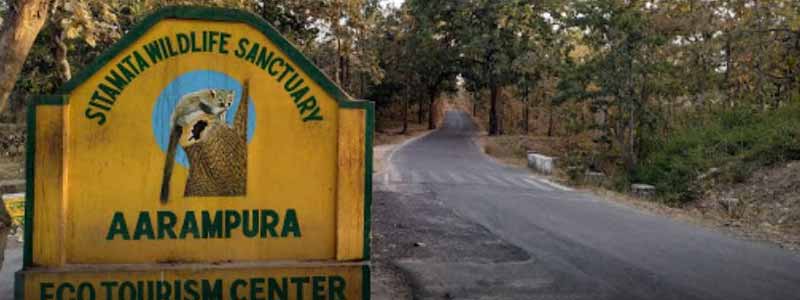
Sita Mata Wildlife Sanctuary
Sita Mata Wildlife Sanctuary, nestled in the picturesque Aravalli Range near Chittorgarh in Rajasthan, India, offers a serene escape into nature’s lap. Covering an area of approximately 422 square kilometers, this sanctuary is a haven for wildlife enthusiasts and nature lovers alike.
The sanctuary derives its name from the legendary figure of Sita Mata, wife of Lord Rama in the Hindu epic Ramayana, adding a touch of mythology to its charm. Its diverse ecosystem comprises lush forests, rocky terrain, and perennial streams, providing a habitat to a variety of flora and fauna.
Visitors to Sita Mata Wildlife Sanctuary can embark on exhilarating jungle safaris to spot a plethora of wildlife species such as leopards, jungle cats, sloth bears, hyenas, and a rich variety of birdlife including the Indian eagle-owl, crested serpent eagle, and more.
Besides wildlife watching, the sanctuary offers opportunities for trekking, birdwatching, and nature photography amidst the tranquil surroundings. The cascading waterfalls and scenic viewpoints add to the allure of this natural paradise 18 Places to visit in Chittorgarh.
For those seeking a rendezvous with nature and a break from the hustle and bustle of city life, Sita Mata Wildlife Sanctuary in Chittorgarh beckons with its untamed beauty and wilderness, promising an unforgettable experience in the lap of nature.
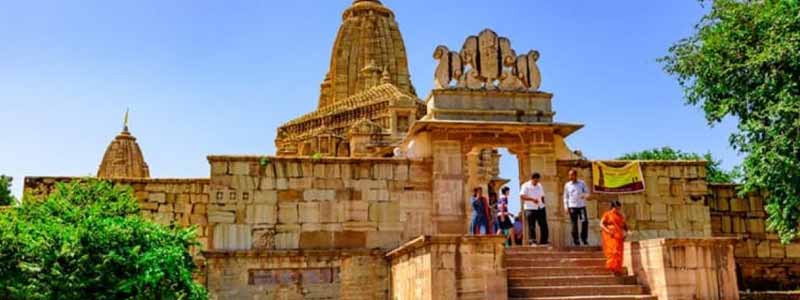
Meera Temple
The Meera Temple in Chittorgarh is a poignant homage to one of India’s most revered mystic poets, Mirabai, who dedicated her life to Lord Krishna. Situated within the confines of the Chittorgarh Fort, this temple holds profound significance for devotees and admirers of Mirabai’s unwavering devotion.
Constructed in the Rajput style of architecture, the Meera Temple exudes an aura of serenity and spirituality. Its intricate carvings, delicate embellishments, and ornate pillars reflect the artistic prowess of the artisans of yore. Within its sanctum sanctorum, a sanctified idol of Mirabai alongside Lord Krishna evokes a sense of divine presence, inviting devotees to immerse themselves in prayer and contemplation.
Visitors to the Meera Temple are greeted by the ethereal strains of bhajans (devotional songs) dedicated to Mirabai, further enhancing the spiritual ambiance of the surroundings. The temple’s tranquil courtyard offers a peaceful retreat for introspection and reflection, away from the bustling crowds of the fort.
For pilgrims and tourists alike, the Meera Temple serves as a beacon of devotion and inspiration, reminding us of the enduring power of faith and love in the journey towards spiritual enlightenment. A visit to this sacred site is not only a cultural excursion but also a soul-stirring experience that leaves an indelible mark on the heart and mind, 18 Places to visit in Chittorgarh.
Shyama Temple
The Shyama Temple in Chittorgarh is a significant religious site revered by devotees of the Hindu faith. Also known as the Kalika Mata Temple, it is dedicated to Goddess Kali, a fierce manifestation of the divine feminine. This temple holds historical and cultural importance, adding to the spiritual ambiance of 18 Places to visit in Chittorgarh.
The architecture of the Shyama Temple reflects traditional Rajasthani style, characterized by intricate carvings, vibrant colors, and elaborate designs. The sanctum sanctorum enshrines the idol of Goddess Kali, adorned with offerings and surrounded by devotees seeking blessings and solace.
Devotees visit the Shyama Temple to offer prayers, seek guidance, and participate in religious ceremonies. The temple holds particular significance during festivals dedicated to Goddess Kali, such as Navratri, when it becomes a hub of fervent worship and celebration.
Beyond its religious significance, the Shyama Temple also attracts tourists and architectural enthusiasts who appreciate its historical and aesthetic value. The tranquil ambiance and spiritual resonance of the temple make it a peaceful retreat for those seeking moments of introspection and divine connection amidst the bustling city of Chittorgarh.
Kriti Stambh
The Kirti Stambha, situated within the majestic Chittorgarh Fort in Rajasthan, India, is a towering epitome of Jain architecture and craftsmanship. Constructed in the 12th century by a Jain merchant named Jijaji Rathod, this seven-story marvel stands as a tribute to Adinath, the first Tirthankara of Jainism.
Rising to a height of 22 meters (72 feet), the Kirti Stambha is adorned with intricate carvings depicting Jain deities, celestial beings, and scenes from Jain mythology. Each level of the tower is adorned with ornate sculptures and friezes, showcasing the mastery of the artisans of that era.
The tower, made entirely of sandstone, reflects the architectural brilliance of the Solanki dynasty, with its elaborate details and precise craftsmanship. It serves not only as a religious monument but also as a symbol of Jainism’s enduring influence in the region.
Visitors to Chittorgarh are captivated by the Kirti Stambha’s serene ambiance and awe-inspiring beauty. It stands as a testament to the rich cultural heritage and religious diversity of India, inviting travelers to marvel at its splendor and delve into the history and spirituality it represents 18 Places to visit in Chittorgarh.
Ratan Singh Palace or Ratan Singh Mahal
Ratan Singh Palace, also known as Ratan Singh Mahal, is a significant historical structure located within the vast expanse of Chittorgarh Fort in Rajasthan, India. Named after Maharana Ratan Singh, a ruler of the Mewar dynasty, this palace stands as a testament to the architectural brilliance and cultural richness of the bygone era.
Constructed in the Rajput architectural style, Ratan Singh Palace showcases intricate designs, ornate carvings, and splendid craftsmanship that exemplify the grandeur of Rajputana architecture. The palace is renowned for its elegant balconies, delicate jharokhas (overhanging enclosed balconies), and spacious courtyards, providing a glimpse into the opulent lifestyle of the royal inhabitants.
One of the highlights of Ratan Singh Palace is its panoramic view of the surrounding landscape, offering visitors a mesmerizing vista of the Chittorgarh cityscape and the picturesque countryside beyond.
Stepping into Ratan Singh Palace is akin to stepping back in time, as it transports visitors to an era of regal splendor and cultural magnificence. Exploring its corridors and chambers, visitors can immerse themselves in the rich history and heritage of Chittorgarh, making it a must-visit destination for history enthusiasts and architectural aficionados alike 18 Places to visit in Chittorgarh.
Bhainsrorgarh Wildlife Sanctuary
Bhainsrorgarh Wildlife Sanctuary, nestled near Chittorgarh in Rajasthan, India, offers a unique wilderness experience amidst the Aravalli Range. Spread over approximately 229 square kilometers, this sanctuary is renowned for its diverse flora and fauna, providing a haven for nature enthusiasts and wildlife lovers.
The sanctuary is characterized by its rugged terrain, rocky cliffs, and dense vegetation, creating a habitat for a variety of species. Wildlife sightings include leopards, hyenas, sloth bears, jungle cats, and various species of deer and antelope. Birdwatchers can delight in spotting a wide array of avian species, including vultures, eagles, owls, and migratory birds during the winter months.
Visitors to Bhainsrorgarh Wildlife Sanctuary can explore the wilderness through guided safari tours, nature walks, and birdwatching excursions, immersing themselves in the natural beauty and serenity of the surroundings. The sanctuary also offers opportunities for photography, allowing visitors to capture the mesmerizing landscapes and wildlife encounters 18 Places to visit in Chittorgarh.
With its tranquil ambiance and abundant biodiversity, Bhainsrorgarh Wildlife Sanctuary is a hidden gem in the Chittorgarh region, inviting travelers to connect with nature and embark on unforgettable wildlife experiences in the heart of Rajasthan.
Archaeological Museum of Chittorgarh
The Archaeological Museum of Chittorgarh, located within the premises of the magnificent Chittorgarh Fort in Rajasthan, India, offers visitors a fascinating journey through the region’s rich history and cultural heritage. Housed in a heritage building, the museum showcases an extensive collection of artifacts dating back to the bygone eras of the region.
Visitors to the museum can explore a diverse range of exhibits, including sculptures, inscriptions, coins, pottery, weaponry, and architectural fragments excavated from various archaeological sites in and around Chittorgarh. These artifacts provide invaluable insights into the artistic, religious, and socio-cultural aspects of ancient Chittorgarh and its surrounding regions 18 Places to visit in Chittorgarh.
Highlights of the museum’s collection include intricately carved sculptures depicting Hindu and Jain deities, relics from the medieval period, and artifacts related to the illustrious history of Chittorgarh Fort, such as armor, swords, and other military paraphernalia.
The Archaeological Museum of Chittorgarh serves as a vital repository of the region’s heritage, offering visitors a deeper understanding of its rich past and contributing to the preservation and promotion of its cultural legacy. For history enthusiasts and curious travelers alike, a visit to this museum is an enriching experience that enhances the exploration of Chittorgarh’s historic charm.





